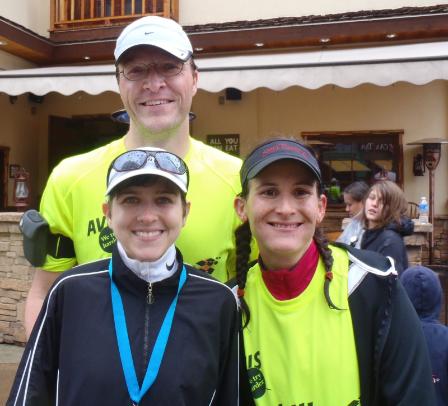Frequently Asked Questions
About Running Blind (Brooke Voss)
Q. Isn’t running boring and difficult, even for people who can see?
A.I think that depends on your attitude. Isn’t it boring and difficult to sit in front of the TV for hours each night? You’d be amazed by what your body and mind can do if you just give them a good talking-to. My legs have no idea that my optic nerves never fully developed. I love to run. Because I can’t see very well, I need to do some things differently than do runners who are fully sighted, (for example, running with a sighted guide). If your workouts are designed to help you meet specific goals, like increasing your speed or endurance, they’re going to be difficult. One of our volunteers, Greg, put it this way, “You have to get comfortable being uncomfortable. The marathon is going to hurt, no matter how good you are, but as soon as you cross that finish line, it gets better.”
Q. Why don’t you use a Guide Dog instead of another person?
A. Well for one thing, I don’t have a guide dog. For another, dogs aren’t very well-adapted to distance running, (especially not in hot climates). There are several things about the way humans are built that makes us great at running long distances, (for more on this, check out Born to Run).
There’s more to being guided than just avoiding obstacles. Information about the terrain can be invaluable to managing my effort. For example, while I can tell that we’re running up a hill, I can’t tell how long it is or if it’s going to get steeper as we go. Having that information helps me manage my effort and my form. Guide Dogs are great, but they can’t provide that kind of information.
Q. How does guiding work?
A. My guide and I run side by side, each holding onto one end of a stretchy, knotted resistance band. Any length of material about 16 inches long works just fine. Ideally, runner and guide have similar stride lengths, but it’s not absolutely necessary. I’m 5’ 3” and my husband is 6’ 5”. We’ve run together countless times and it works great.
How much information the guide provides depends on both runners’ familiarity with the terrain, and sensitivity to each other’s movements, and on the amount of usable vision the visually impaired runner has. There are a lot of levels of visual acuity between “sighted” and “blind”. What I can see depends on contrast, lighting, movement and contextual cues. Slopes and dips are particularly tough because I have no depth perception, (my optic nerves are underdeveloped, which means that my brain gets some, but not all, of the data my eyes take in. A lot of texture is missing, and that’s one of the things that helps your brain understand how far away something is from you.).
For me, verbal directions are really helpful, and the more succinct, the better. “Curb up in three, two, one” provides precise information quickly enough for both of us to react. Since runners react to a short slope differently than to a long downhill, that difference is important too.
Q. Do you have to go through training to be a guide?
A. There are several methods for sighted guiding, but there’s no formal certification or anything like that. I think the main thing is for runner and guide to have a clear understanding of what kinds of information are helpful. Since my own family are still sometimes surprised by what I can and can’t see, I can’t expect someone I’ve just met to intuitively understand what kinds of information I might need. Communication is key, before, during and after the run.
Q. You’re awesome for being blind and running!
A. Oh knock it off. J I know you mean well, but I’m not the one doing the furious, awesome multitasking during these runs. A good guide has to manage his or her own pace, effort, form and navigation and watch out for me. He or she has to make split-second decisions about avoiding obstacles, what information to provide and when to provide it. It takes a lot of concentration and energy.
Guiding is a partnership that’s always developing and being refined. It requires trust, clear communication and patience from both parties. Without the people who’ve been kind enough to guide me, I wouldn’t be the runner I am today. They are awesome for running with me through—literally—rain and sleet and hail and dark of night, to say nothing of 90-degree desert afternoons.
It was my husband, Torsten, who first volunteered to guide me. He was an avid hiker, but hadn’t run since high school. At 6’ 4’ and—back then—about 235 pounds, he wasn’t sure he had the build for it. Still, after a couple of weeks of watching me do treadmill workouts, he pointed out that if I wanted to be a better runner, I needed to run outside. We’ve been running together ever since. How many people would take up a sport so that their spouse could do so? Bonus husband-points: it was mid-July when we first started running outdoors. (I told you guides are awesome. J)

